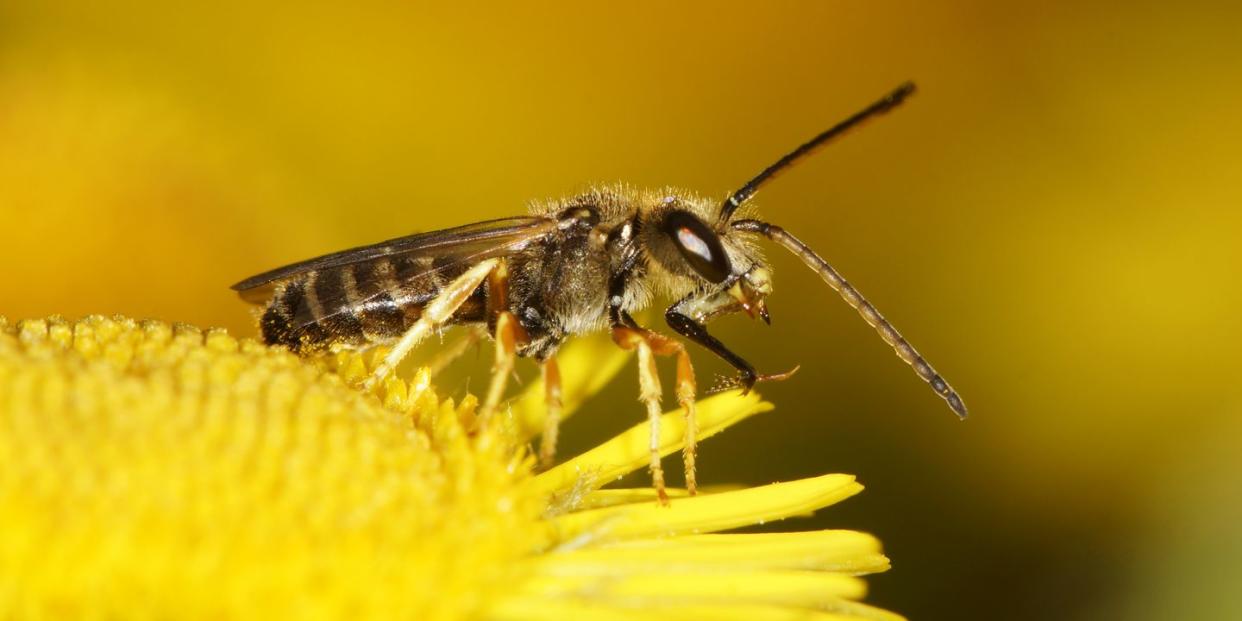How to Get Rid of Sweat Bees When They Won’t Leave You Alone

Being outside is crucial these days, but given how hot summer temperatures can get, you’re probably doing a fair bit of sweating. With that comes those awkward, midday clothing changes, extra deodorant, and the potential to attract annoying pests—yes, including sweat bees.
While you may have encountered these tiny, perspiration-loving insects at some point, it’s understandable that you might not know a lot about them. The word “bee” is instantly associated with a mighty sting, but keep this in mind, per entomologist Roberto M. Pereira, Ph.D., a research scientist with the University of Florida: “While they can be annoying, sweat bees really won’t do any harm to people.”
Here’s what you need to know about sweat bees, why they love your post-workout glow, and what you can do to keep them away from you.
What are sweat bees, exactly?
There are actually a lot of different types of sweat bees out there. “Sweat bees are in the halictid family of bees, and there are over 500 different species in the U.S.,” says entomologist Rufus Isaacs, Ph.D., a professor at Michigan State University. “They are a diverse group of insects that include some important pollinators.”
Sweat bees are tiny as far as bees go—they usually measure ½ an inch or less in length—and they come in a range of colors, including shades of green, bronze, and black, says board-certified entomologist Nancy Troyano, Ph.D., director of operations education and training for Ehrlich Pest Control.
Just like “regular” bees, sweat bees are attracted to flowers and pollinate them. “They are helpful pollinators in our gardens, orchards, and native areas,” says Meghan Milbrath, Ph.D., an assistant professor of entomology and program coordinator of the Michigan Pollinator Initiative.
Where do sweat bees live?
In the U.S., they can be found all over, although many species are in the eastern part of the country. “They can live in colonies or alone, depending on the species,” Troyano says.
Sweat bees like to nest in soil and old wood, Isaacs says. As a result, you’re probably more likely to run into sweat bees in the woods or while hanging out in a grassy park than you are walking down a city street.
Do sweat bees actually eat your sweat?
It’s gross, but true: Sweat bees eat sweat. “Sweat bees primarily feed on pollen and nectar of flowers. However, they do need to supplement their diets with salt and moisture, which is why they are attracted to human sweat,” Troyano says.
Do sweat bees sting?
They can, although it’s usually not an intense feeling. “Sweat bees will only sting if provoked, and they are just looking for a little salt in the sweat on your skin when they land on you,” Isaacs says. “Their sting is also quite mild, but its nothing like a wasp or honey bee sting.” For what it’s worth, Isaacs says he’s worked for 20 years to develop a garden to attracted pollinators and has been stung by a sweat bee “exactly zero times.”
How to get rid of sweat bees if they bother you
Getting rid of them can be tricky and, as Milbrath points out, they can be helpful for keeping your plants in good health. That said, there are a few things you can do to lower the risk they’ll hang around your home:
Get rid of rotting wood. Troyano recommends removing old branches and logs from around your home to give sweat bees one less place to nest.
Fill in burrows or holes in the ground. Pay extra attention to ones in sunny areas, since sweat bees tend to set up shop there.
Wear insect repellent. OTC insect repellents will help “deter sweat bees from landing on you and stinging,” says board-certified entomologist, Glen Ramsey, senior technical services manager at Orkin.
Limit how much skin you expose. This can be tricky on a hot day, but “limiting exposed skin, especially where sweating is common, will help to limit the bee’s ability to land and feed,” Ramsey says.
Doing your best to be indoors when you’re extra sweaty, like heading directly inside to rinse off after a tough workout, can also help lower the risk they’ll swarm you. If a sweat bee does land on you, Troyano says that it’s “important to stay calm.” Then, just gently brush the bee away. “Sweat bees are not generally aggressive, but females can sting if threatened—particularly if they are being swatted,” she says. (If you do wind up with a sting, here’s how to treat it properly.)
If you have a sweat bee infestation around your home or it feels like you can’t go outside without being accosted by them, it’s time to call in a pest management expert for help. They can help locate the nest and take them out—so you can sweat outdoors in peace.
Support from readers like you helps us do our best work. Go here to subscribe to Prevention and get 12 FREE gifts. And sign up for our FREE newsletter here for daily health, nutrition, and fitness advice.
You Might Also Like

